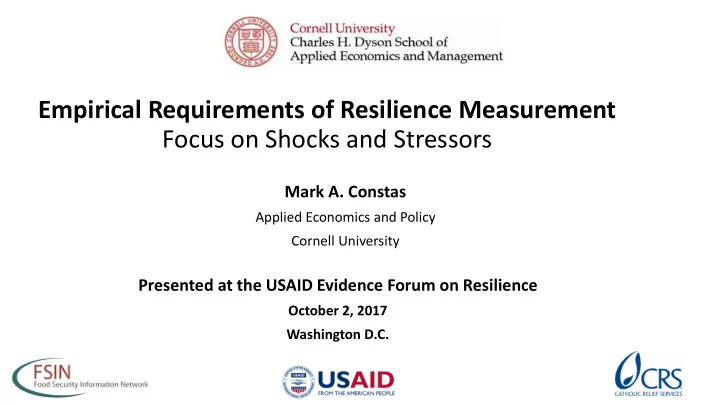

Empirical Requirements of Resilience Measurement Focus on Shocks and Stressors Mark A. Constas Applied Economics and Policy Cornell University Presented at the USAID Evidence Forum on Resilience October 2, 2017 Washington D.C.
Background • Rationale for improved shock measurement • Core variable in resilience analysis • Motivation • Empirical and methodological
Empirical Motivation – What needs to be measured? Droughts Floods Pests Political Conflicts Diseases Food Prices Interactions Individual and combined effect of shocks and stressors on well-being Loss of Personal Social Economic Food Immediate Diminished Livelihoods Safety Welfare Instability Insecurity Mortality Health
Methodological Motivation • Sensitivity to resilience • Focused measurement of shocks • Well-being over time • Higher/appropriate frequency & longer/appropriate durations • Consider rates of change, volatility, and durability • Lower burden • Protection against fatigue and attrition • Programmatically integrated • Maximize alignment and minimize attrition
2015 Flood 2016 Drought Empirical Study: Context Malawi/Chikwawa • 2015 flooding displaced an estimated 230,000 people & damaged about 64,000 hectares of land • Followed by drought in brought on by El Nino • An estimated 3 million people are vulnerable to famine (FAO) UBALE -United in Building and Advancing Life Expectations • Overlapping interventions to reduce malnutrition and build resilience. • UBALE program plans to work with 235,000 households between 2014 and 2019 IPC 2.0 Acute Food Insecurity Phase
Malawi Study: Measurement Indicators for Resilience Analysis (MIRA) Empirical Application Focus on Shock Metrics for Resilience Analysis MIRA Protocol Monthly low-burden cell-phone based surveys, 15 min max.. • Village level, administered by local program staff • Shock module, asset module, HH characteristics module, CSI.. • Focus on Shock Module for Resilience Analysis Weather Shocks Agriculture Shocks Economic Shocks Household Shocks Health Shocks • Drought • Crop pest/disease • Business failure • Death in household • Cholera or other Flood • Livestock – death • Loss of job/non- • Break-up of the serious illness • • Wind damage or disease payment of salary household • End of regular • Theft assistance/aide • House damaged due • End of remittance from to fire outside HH • Fall in crop prices • Rise in prices of food
Analysis of Shocks for Resilience Analysis Results • Temporal properties of shocks • Distribution of single shocks over time • Shock combinations • Most common combinations Multiple correspondence • Spatial properties of shocks analysis • Concentration and dispersion across sites
Distribution of Single Shocks Over Time Temporal Distribution of Shocks: Aggregate Across Malawi Study Sample 25.00% 20.00% 15.00% Round 12 10.00% 5.00% 0.00% Round 1
Empirical Application Examining shock combinations Single round or time period Two Shock Combinations Three Shock Combinations
Frequency of Shock Dyads and Triads: by Traditional Authority Single round or time period Three Shocks Two Shocks
Shock Combinations Findings from Multiple Correspondence Interpretation First set - Job loss, wind, and theft - best fit for 1 st dimension Second set- end of assistance, flood, livestock loss - best fit for 2 nd dimension Third set – illness, rise in food prices crop disease – best for both dimensions
Shock Combinations Focus on Spatial Variation-Concentration
Conclusion Part Four Opportunities to Improve the Resilience Measurement • Opportunity 1: Measure how shocks and stressors interact • Need for Multidimensional shock index • Opportunity 2: Examine temporal aspects of shocks and stressors Next Steps • Shock Components • Persistent effects & shock propagation effects Index • Opportunity 3: Model interactions and cumulative effects • Combine with • Sensitivity to temporal dynamics and shock combinations resilience analysis • Opportunity 4: Apply analytical techniques exploit data density • Greater precision by leveraging high frequency data set +75,00 data points Understanding of shock dynamics-> prediction of observed well-being variability Better Evidence for Targeting and Decision Making
Thank you! Contact: Mark.Contas@cornell.edu
Recommend
More recommend